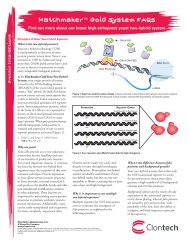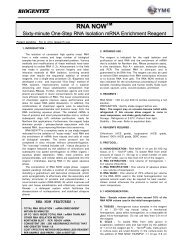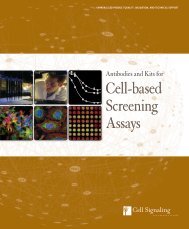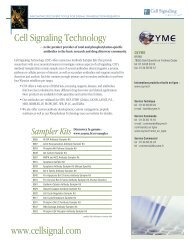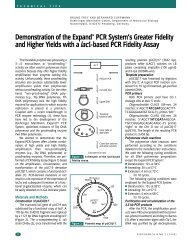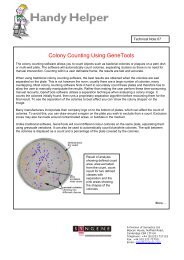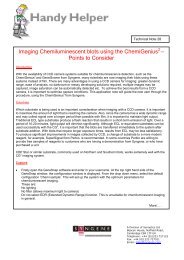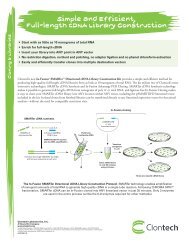DNA polymerase fidelity and the polymerase chain reaction. - Ozyme
DNA polymerase fidelity and the polymerase chain reaction. - Ozyme
DNA polymerase fidelity and the polymerase chain reaction. - Ozyme
You also want an ePaper? Increase the reach of your titles
YUMPU automatically turns print PDFs into web optimized ePapers that Google loves.
Downloaded from genome.cshlp.org on October 11, 2011 - Published by Cold Spring Harbor Laboratory Press<br />
<strong>DNA</strong> Polymerase Fidelity<br />
<strong>and</strong> <strong>the</strong> Polymerase Chain<br />
Reaction<br />
Kristin A. Eckert <strong>and</strong> Thomas A. Kunkel<br />
Laboratory of Molecular Genetics, National Institute of Environmental Health<br />
Sciences, Research Triangle Park, NC 27709<br />
The distinctive ability of <strong>the</strong><br />
<strong>polymerase</strong> <strong>chain</strong> <strong>reaction</strong> (PCR) to<br />
produce a substantial quantity of <strong>DNA</strong><br />
from an initially small amount of genetic<br />
material is revolutionizing<br />
molecular biology. The variety of highly<br />
successful applications of PCR technology<br />
<strong>and</strong> <strong>the</strong> ease with which PCR<br />
can be performed should not be<br />
misinterpreted as evidence that <strong>the</strong><br />
PCR is a simple process. In fact, quite<br />
<strong>the</strong> opposite is true. A single cycle of<br />
<strong>DNA</strong> polymerization is a complex process<br />
requiring <strong>the</strong> precise interaction of<br />
several components. The repetitive<br />
cycles characteristic of PCR provide an<br />
additional layer of complexity to <strong>the</strong><br />
technique. The final PCR product cannot<br />
be considered a unique entity, as<br />
even a discrete <strong>DNA</strong> b<strong>and</strong> on an<br />
agarose gel may contain a variety of<br />
<strong>DNA</strong> molecules differing from <strong>the</strong><br />
original genetic information by one or<br />
more nucleotides.<br />
How serious a concern is <strong>the</strong> <strong>fidelity</strong><br />
of PCR The answer depends on <strong>the</strong><br />
precise nature of <strong>the</strong> application. In<br />
many instances, for example, direct<br />
characterization of <strong>the</strong> amplified population<br />
by <strong>DNA</strong> sequence analysis or<br />
nucleic acid hybridization, r<strong>and</strong>om errors<br />
in nucleotide sequence that may<br />
be produced during PCR are of little<br />
concern. However, some PCR applications<br />
involve <strong>the</strong> characterization of<br />
individual <strong>DNA</strong> molecules or rare<br />
molecules present in a heterogeneous<br />
population. Examples include <strong>the</strong><br />
study of allelic polymorphism in individual<br />
mRNA transcripts O,2) <strong>and</strong> <strong>the</strong><br />
characterization of <strong>the</strong> allelic states of<br />
single sperm cells (3) or single <strong>DNA</strong><br />
molecules. (4,s) In <strong>the</strong>se circumstances,<br />
<strong>the</strong> <strong>fidelity</strong> (error rate per nucleotide)<br />
of PCR is an important consideration,<br />
because errors generated during<br />
amplification may interfere with <strong>the</strong><br />
interpretation of data.<br />
During enzymatic <strong>DNA</strong> amplification,<br />
<strong>the</strong> majority of changes in nucleotide<br />
sequence can be attributed to errors<br />
made by <strong>the</strong> <strong>DNA</strong> <strong>polymerase</strong>.<br />
While PCR is a recent development in<br />
<strong>the</strong> field of molecular biology, <strong>the</strong> <strong>fidelity</strong><br />
of <strong>DNA</strong> <strong>polymerase</strong>s has been<br />
studied biochemically for almost 30<br />
years. In this review, we will attempt to<br />
relate our current underst<strong>and</strong>ing of <strong>the</strong><br />
mechanisms of <strong>polymerase</strong> <strong>fidelity</strong> in<br />
vitro to <strong>the</strong> accuracy of enzymatic<br />
<strong>DNA</strong> amplification. We begin by describing<br />
steps in <strong>polymerase</strong> error discrimination<br />
<strong>and</strong> variables important<br />
for determining <strong>fidelity</strong>. The error rates<br />
of several <strong>DNA</strong> <strong>polymerase</strong>s that have<br />
been used for PCR will be described,<br />
first as determined in model "onecycle"<br />
<strong>fidelity</strong> assays <strong>and</strong> <strong>the</strong>n during<br />
actual PCR. Our intent is to focus on<br />
<strong>the</strong> variables known to influence <strong>the</strong><br />
<strong>fidelity</strong> of <strong>DNA</strong> syn<strong>the</strong>sis in vitro that<br />
can be controlled experimentally.<br />
ERROR ACCUMULATION<br />
PCR<br />
DURING<br />
Error rates in PCR vary according to<br />
<strong>the</strong> precise <strong>DNA</strong> sequence <strong>and</strong> <strong>the</strong> in<br />
vitro conditions of <strong>DNA</strong> syn<strong>the</strong>sis.<br />
Several laboratories have estimated <strong>the</strong><br />
error frequency (mutations per<br />
nucleotide per cycle) during PCR<br />
catalyzed by <strong>the</strong> <strong>the</strong>rmostable Thermus<br />
aquaticus (Taq) <strong>DNA</strong> <strong>polymerase</strong> by<br />
cloning individual <strong>DNA</strong> molecules<br />
from <strong>the</strong> amplified population <strong>and</strong><br />
determining <strong>the</strong> number of <strong>DNA</strong> sequence<br />
changes. (6-12) As seen from <strong>the</strong><br />
data in Table 1, observed error frequencies<br />
during PCR vary more than 10-<br />
fold, from -2 x 10 -4 to



